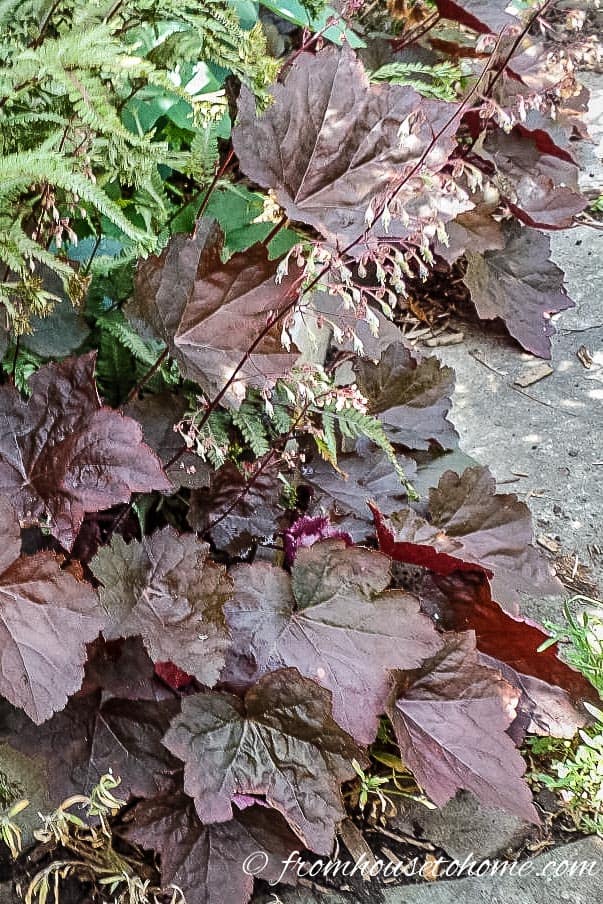Shade-Loving Perennials: Stunning Ground Cover Plants That Control Weeds Effortlessly
These beautiful compact perennials can be used as ground cover plants for shade. They will add interest to the shady areas of your garden while helping to keep the weeds down.

Compact perennial plants that can be planted under taller plants add interesting layers to your garden and help to keep the weeds down.
Although there are some shade ground cover perennials that bloom brilliantly without much sun, many rely more on foliage and color variations rather than flowers to create interest.
I find that dense planting of shade tolerant perennials requires very little maintenance and minimal weeding, as long as they are adequately watered. I also amend the soil with compost and triple mix prior to planting and use a thick layer of mulch to retain moisture and restore nutrients.
These are some of my favorite compact shade perennials that grow to be less than 18” high, and are excellent ground covers.
Low maintenance & non invasive plants
When you read through the first section of plants, you may be wondering why you don't see the standards (like Periwinkle and Pachysandra) in the list.
The reason is that I don't like to plant them in the garden.
They can be hard to keep in check once they get established, so I stick to more low maintenance and non-invasive ground covers.
However, in case you need to cover a large area and don't mind doing some extra work, I included those more aggressive plants at the bottom of the list.
1 | Hellebore (Lenten Rose or Christmas Rose)
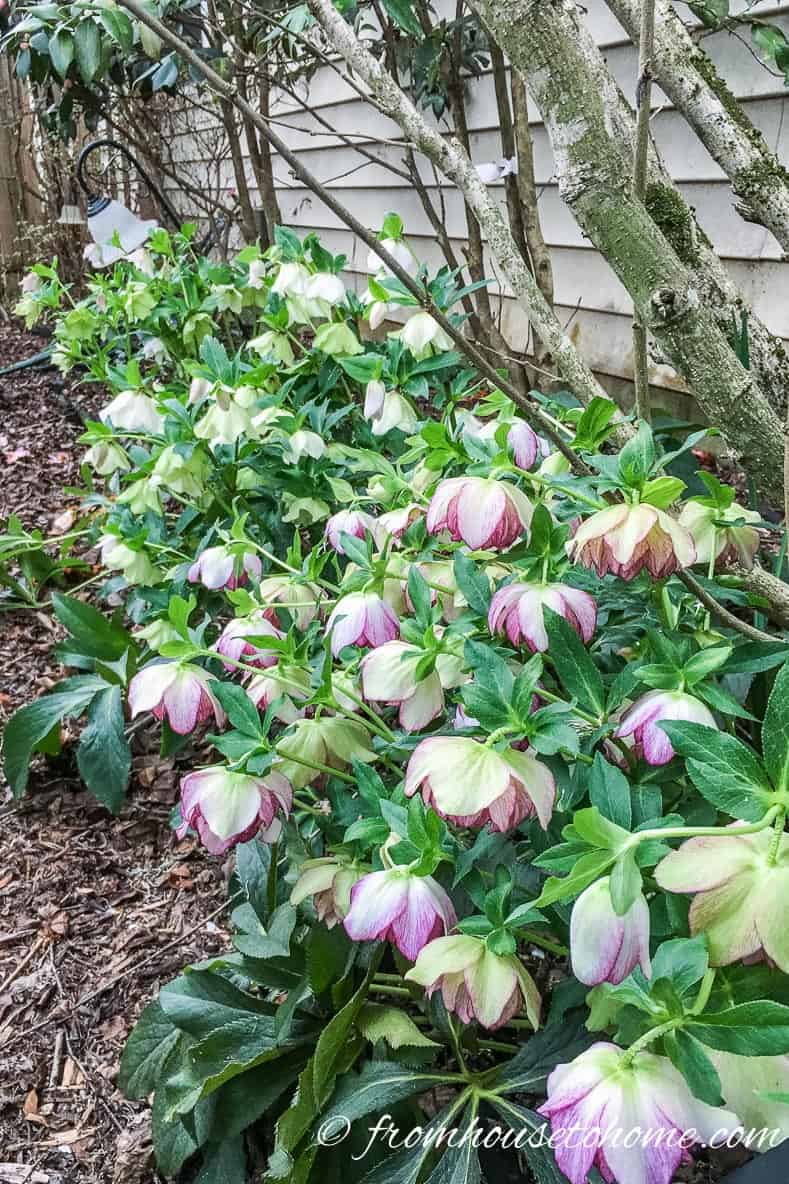
Zones: 4 to 9
Light: Shade
Bloom Time: Late Winter to Early Summer
Height: 12″ to 18″
Spread: 18″ to 24″
Hellebore is one of the first plants to bloom in the spring, earning it the nickname ‘Christmas rose'. But even though it starts early, it can continue to blossom all spring.
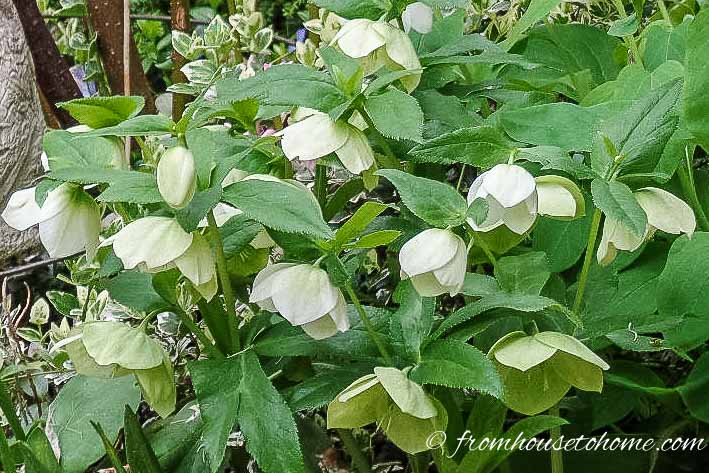
The foliage is evergreen and low growing–which makes it a perfect plant for the front of a shady border.

The blooms range in color from cream, light green, speckled pink or burgundy to glorious double pink or white in the hybrid ‘Ellen’ series.
The only maintenance I do, is to tidy the appearance by removing any dead leaves.

They have become very popular, which means new varieties are coming out all the time, like these ones with double flowers.

Or these purple ones.
Find more information about growing Hellebores HERE.
2 | Brunnera macrophylla ‘Jack Frost’
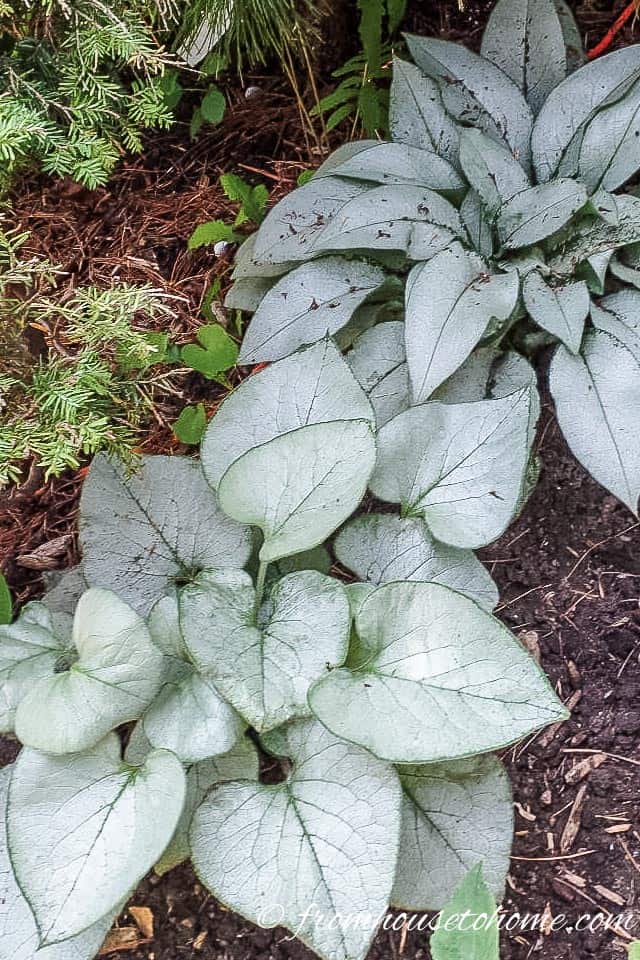
Zones: 3 to 8
Light: Partial Shade to Shade
Bloom Time: Spring
Height: 12″ to 15″
Spread: 12″ to 24″
‘Jack Frost' Brunnera has gorgeous large, variegated, silver heart-shaped leaves, and sports dainty blue flowers in the spring.

It likes moist soil that isn't too wet and grows into a lovely mounded plant that fairly glows in the shaded environment.
Leave the foliage to protect the crown over winter and trim it back in the spring.
3 | Hosta

Zones: 3 to 9
Light: Shade To Part Shade
Bloom Time: Summer
Height: 6″ to 6′ (depending on the variety)
Spread: 12″ to 6′ (depending on the variety)
Hosta is an old standby perennial ground cover that now is available in a variety of variations, leaf and plant size.

I like to put those varieties that have cream, white, or lime green foliage in the darkest spots so that they pop, particularly at night.

I have a particular fondness for the tough, leathery or waxy leaved hostas because they repel slugs and maintain neat mounds.

Large hostas are big enough to be the backbone of your shade border.
Most hostas bloom mauve or white in summer.

Learn more about Hostas:
4 | Dwarf Astilbe
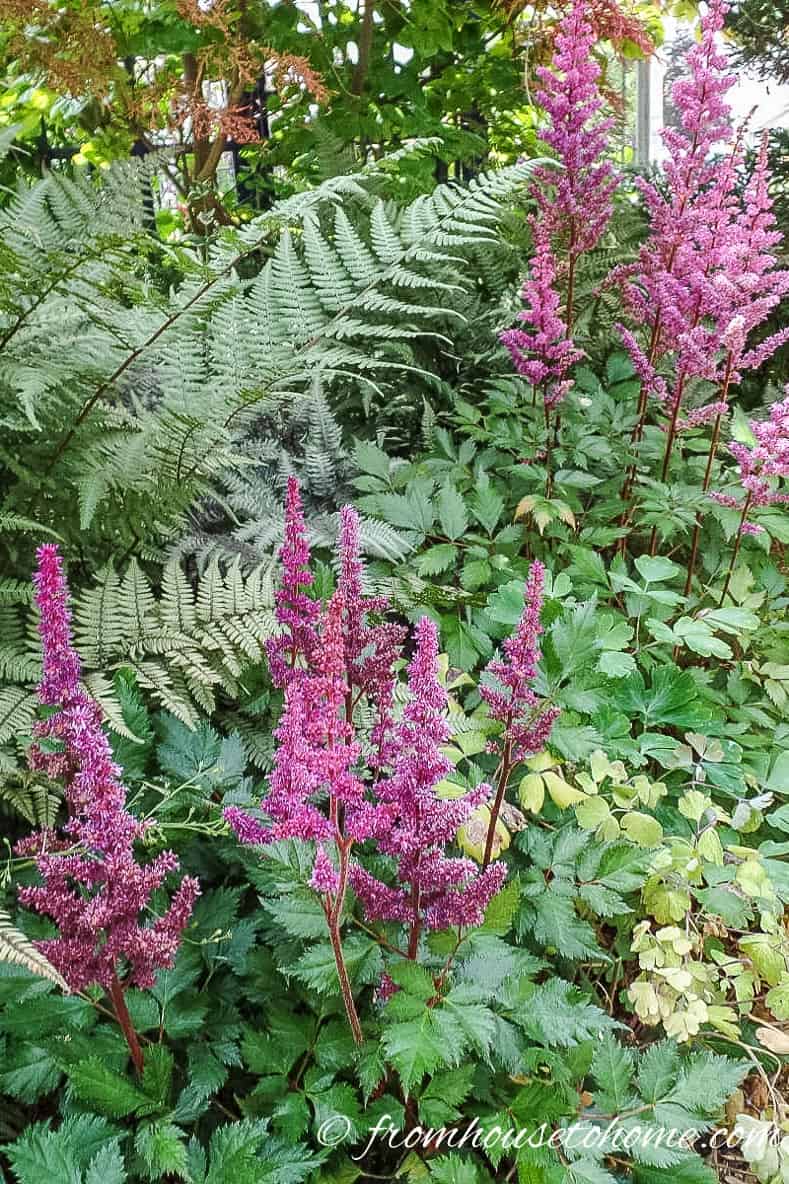
Zones: 4 to 9
Light: Part Shade To Shade
Bloom Time: Summer To Fall
Height: 12″ to 24″
Spread: 12″ to 24″
With their deer-resistant leaves and pretty purple or pink flowers, the dwarf varieties of Astilbes (Astilbe chinensis) are perfect ground covers for your shade garden.
Astilbe's fern-like leaves and delicate blooms add interest to any shady spot.

Different Astilbe varieties will grow in a variety of light conditions, so be sure to read the growers tag and choose those varieties identified as preferring shady conditions.
Also, pay attention to the height of the plant. There are taller and shorter varieties so pick the ones that are most appropriate for your setting.
5 | Dwarf Hydrangeas

Zones: 5 to 9
Light: Part Shade to Shade
Bloom Time: Summer to Fall
Height: 1′ to 3′
Spread: 2′ to 4′
There are now many Dwarf hydrangeas that can be included in the shade garden, most notably the Cityline series which is bred for compactness.
Technically they are bushes but I love them so much that I feel compelled to mention them here.
Especially since their dense growth and large leaves make them an excellent ground cover.
The color of the blooms depends upon the acidity (blue) or alkalinity (pink) of the soil.

I particularly like Hydrangea macrophylla ‘Pistachio’ because it is a dwarf plant with different colors than you normally see in Hydrangeas (red blooms with lime green centers), and the color is unaffected by soil PH.
Hydrangea bushes generally bloom all summer and into the fall.
Note: There are a few different varieties of Hydrangea with different sunlight requirements, so make sure you are getting one that is meant to grow in the shade. Click HERE to get more information on Hydrangeas.
6 | Ground Cover Cranesbill (Geranium macrorrhizum)

Zones: 4 to 8
Light: Part Shade to Sun
Bloom Time: Late Spring to Summer
Height: 12″ to 18″
Spread: 12″ to 24″
Geranium macrorrhizum is a drought-tolerant and shade-tolerant perennial with semi-evergreen, fragrant leaves.
There are hardy geraniums for most garden situations, yes, even as a ground cover for dappled and full shade.
Cranesbill is extremely easy to grow but needs well drained soil.
Abundant flowers cover the mounding foliage in late spring. And if cut back hard after the first flush of blooms, it can bloom all summer and into fall.
They attract butterflies and repel deer and rabbits.
The foliage turns color in the fall which extends its interest in the garden.
7 | Japanese Painted Fern (Athyrium niponicum)

Zones: 4 to 9
Light: Shade to Part Shade
Bloom Time: Foliage Only
Height: 12″ to 24″ (depending on the variety)
Spread: 18″ to 36″
Japanese painted ferns are a boon to garden designers.
With their blue green leaves, burgundy variations, and compact growth habit they are extremely interesting.
Like most ferns, these perennials don't like to dry out, so make sure to provide consistent water. Otherwise, they are very low maintenance plants.

Variation “pictum” (find it HERE*) has red stems and pewter colored leaves that reflect light.

Whereas ‘ghost’ (find it HERE*) has whitish green fronds that brighten up a dark space.
Click HERE for more fern varieties that will grow in the shade.
8 | European Ginger (Asarum europaeum)

Zones: 2 to 9
Light: Shade
Bloom Time: Spring
Height: 6″ to 12″
Spread: 12″ to 24″
Ginger is perfect for ground cover under a bush or grown among rocks.
The European variety has attractive round shiny leaves and grows much slower than North American wild ginger.
Although it blooms in the spring, the blooms are insignificant and most gardeners plant it for its beautiful foliage.
9 | Golden Japanese Forest Grass (Hakonechloa macra ‘Aureola’)

Foliage Only
Zones: 5 – 8
Light: Part Shade
Height: 18 to 24″
Spread: 18 to 24″
Glowing with strands of gold that are banded in green, Japanese forest grass drapes gracefully over rock borders or edges of walls.
Its brightly colored leaves really stand out in the shade.

Japanese forest grass is a low maintenance bright edging that flutters in the breeze.

The delicate leaves look beautiful with many other shade plants, such as Hostas and Bluebells.
10 | Coral Bells (Heuchera)
Zones: 4 to 9
Light: Shade to Part Shade
Bloom Time: Spring
Height: 6″ to 18″
Spread: 12″ to 30″
Commonly called coral bells, Heuchera foliage provides great color in the shade garden.
The leaves come in a range of hues from almost black, dark purple, chartreuse, peach and orange and have an interesting lobed shape.
It does not like to be planted too deep, so set the crown at ground level.

This plant does have insignificant little flowers, but it is mainly grown for its beautiful foliage, like these yellow and orange varieties grown with Lamium in the middle.
It was named Plant of the Year in 2012.
11 | English Primrose (Primula vulgaris)

Zones: 4 to 8
Light: Part Shade
Bloom Time: Late Winter to Early Spring
Height: 4″ to 6″
Spread: 4″ to 9″
English primrose (Primula vulgaris) is a compact, semi-evergreen plant with small, scented, pale yellow colored flowers that appear from late winter to early spring.
It self-seeds so it will naturalize under bushes and trees to form a blanket of green leaves during the summer.
Then in late winter or early spring, you'll be rewarded with a sunny show of flowers before most other plants have started to grow.
English primrose is such a joy to have in the garden that it received the prestigious Award of Garden Merit from the Royal Horticultural Society.
Ground Covers To Plant With Caution

As I mentioned above, there are a few classic ground cover plants that I did not include in my original article because they can be invasive.
However, after seeing them used very effectively at the Proven Winners Garden tour on Mackinac island last August, I am amending the list. The garden above has periwinkle, lamium and pachysandra all used in one garden bed!
Mackinac Island is in Zone 4 so the cooler temperature may help to keep these plants manageable.
I recommend that you check with your local nursery before planting them in your garden, particularly in warmer climates.
12 | Pachysandra terminalis

Zones: 5 to 9
Light: Shade
Bloom Time: Spring
Height: 8″ to 12″
Spread: 12″ to 24″
Pachysandra is a low growing ground cover that is native to the North Eastern United States and spreads by rhizomes in full shade.
It is an easy-to-grow, drought-, deer-, and rabbit-resistant plant with small white flowers in early spring.
It is also relatively easy to pull out if it spreads where you do not want it which makes it less work to maintain than some of the other classic ground cover perennials.
13 | Lamium

Zones: 2 to 9
Light: Shade
Bloom Time: Summer
Height: 3″ to 8″
Spread: 12″ to 24″
Lamium, a low growing member of the mint family, has lovely pewter variegated leaves that glow in the shaded garden.
The flowers range from white to pink to purple — ‘purple dragon' has the biggest flowers.
Like other members of the mint family, it is a fast growing plant that spreads rapidly by rhizomes and rooting at the stem joins, and is considered to be mildly invasive.
Lamium will choke out small plants so plant it under tough perennials and bushes.
If it spreads too far, it can be contained by pulling out the unwanted plants.
14 | Periwinkle (Vinca Minor)

Zones: 4 to 8
Light: Shade
Bloom Time: Spring
Height: 4″ to 8″
Spread: 24″ or more
Periwinkle is a fast growing evergreen ground cover that has pretty blue or purple flowers in the spring with glossy dark green foliage.
Vinca is tolerant of drought, shade, deer, and rocky, clay or sandy soils. A very tough plant!

It spreads aggressively by rooting at the nodes of the trailing stems and is quite difficult to pull once it is established. So plant it where you want a thick ground cover that is only a few inches tall.
15 | Bugleweed (Ajuga reptans)

Zones: 4 to 10
Light: Shade to Sun
Bloom Time: Spring
Height: 6″ to 12″
Spread: 12″ to 48″
Bugleweed will form a dense, evergreen mat of shiny, dark green leaves with spikes of violet-blue flowers that makes a great groundcover.
This shade-loving perennial spreads by underground runners called stollens as well as by self-seeding. Cut off the spent flowers to prevent the latter.
Give careful consideration to the placement of Ajuga because it will creep into lawns and can be difficult to eradicate.
However, it is useful under trees where grass will not grow (it is one of the few plants that will survive under a black walnut tree).
It also tolerates dry shade and is deer resistant.
16 | English Ivy (Hedera helix)

Zones: 4 to 9
Light: Shade
Bloom Time: Fall
Height: 1′ to 3′ (depending on the variety)
Spread: 10′ plus
Ivy is a low, rapidly growing vine that needs to be planted carefully because of its invasive nature, especially when used as a ground cover.
This evergreen performs well under trees in dense shade where most other plants will not grow.
Although English Ivy does bloom, the flowers are not particularly ornamental.
Note that it is toxic to animals and humans.
17 | Lily of the Valley (Convallaria majalis)

Zones: 2 to 9
Light: Sun
Bloom Time: Spring
Height: 6″ to 12″
Spread: 12″ or more
A poisonous, invasive plant with white bell shaped flowers that smell divine, the lily of the valley spreads by stollens and rhizomes.
Once this tough plant forms a colony it is very difficult to dig out.
However, it is a drought and shade tolerant plant that is not bothered by deer or rabbits.
18 | Woodland or Alpine Strawberry (Fragaria vesca)

Zones: 3 to 10
Light: Part shade
Bloom Time: Spring to summer
Height: 6″
Spread: 12″ to 24″
Alpine strawberry is native to North America where it grows on the edges of woody areas allowing it to get a few hours of sun.
These plants are small, easy to grow and produce white flowers followed by small aromatic edible fruit all summer.
If propagating from seed, start the seed in flats indoors, progress to pots, then harden off before planting into the garden.
Roots are shallow so they need to be kept well mulched.
Companion Plants For Ground Covers
These plants aren't ground cover plants themselves, but they all have pretty blooms that make great companion plants for ground covers.
Some of these can create carpets of flowers on their own but go into dormancy in the summer. So you will need to plant them with something that will fill in the gaps.
Others are just compact plants that provide some color to the shade garden by flowering above foliage-only ground covers.
19 | Trillium

Zones: 4 to 9
Light: Shade
Bloom Time: Spring
Height: 12″ to 18″
Spread: 12″ to 18″
I like to plant Trilliums under rhododendrons and evergreens to enjoy the distinctive white or red blooms.
Since this native plant likes rich acid soil, it is very happy being situated with these other acid-loving plants.
It is a little particular about being disturbed after it has been planted so try to put it in its forever home right from the beginning.
If the foliage or blossom is broken the plant will not bloom for two years and may even die.

Although it spreads by rhizomes (and will naturalize), it is not at all invasive and co-exists easily with other spring plants.
Once the weather starts to get warmer, Trilliums go completely dormant. You might want to mark their location so that you don't accidentally dig them up.

Trillium is the official flower of the Canadian province of Ontario and the State of Ohio.
20 | Bleeding Heart (Dicentra)

Zones: 2 to 9
Light: Shade to Part Shade
Bloom Time: Spring
Height: 1′ to 3′ (depending on the variety)
Spread: 1′ to 2′
Bleeding heart is another one of the spring blooming low growing perennials that goes dormant in the summer.
But the blooms are so beautiful that it's definitely worth having in your shade perennial border.
It's also deer resistant and easy to grow which makes it a great companion plant for your ground covers.
21 | Virginia Bluebells (Mertensia virginica)

Zones: 3 to 8
Light: Part Shade / Shade
Bloom Time: Spring
Height: 18″ to 24″
Spread: 12″ to 24″
Virginia Blue Bells is a lovely native plant, commonly referred to as Virginia cowslip, which produces bell shaped flowers that start out pink and mature to lavender blue.

It goes completely dormant after blooming in the spring, which gives me an opportunity to double plant with Japanese painted fern (another one of our perennial ground cover plants for shade).

22 | Columbine (Aquilegia)
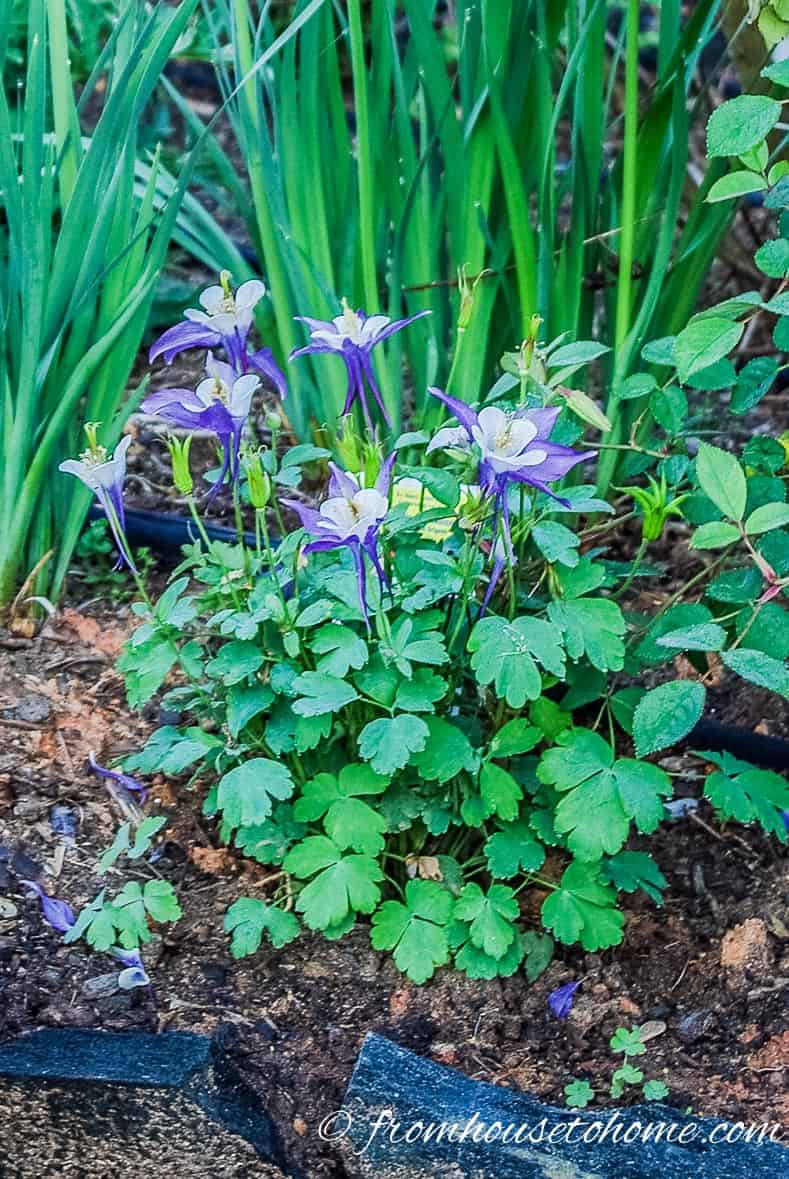
Zones: 3 to 9
Light: Part Shade
Bloom Time: Spring
Height: 12″ to 24″
Spread: 12″ to 18″
Columbines have pretty flowers that come in many different colors above lacy foliage and are just an all-around pretty plant.

They do tend to self-seed (although not too aggressively) so you may find them growing up in places where you didn't expect them. But I like them so much I usually just let them grown where they want to!
Find out more about them HERE.
Other Shade Plants You Might Like
- 9 of the Best Flowering Vines For Shade
- Shade Loving Shrubs: 11 Beautiful Bushes To Plant Under Trees
- 15 Beautiful Deer Resistant Shade Plants To Grow In Your Garden
- Tall shade perennials
- Perennials that thrive in dry shade
Do you have any favorite perennial ground cover plants for the shade? Tell us in the section below.
Pin It So You Don't Forget It!


